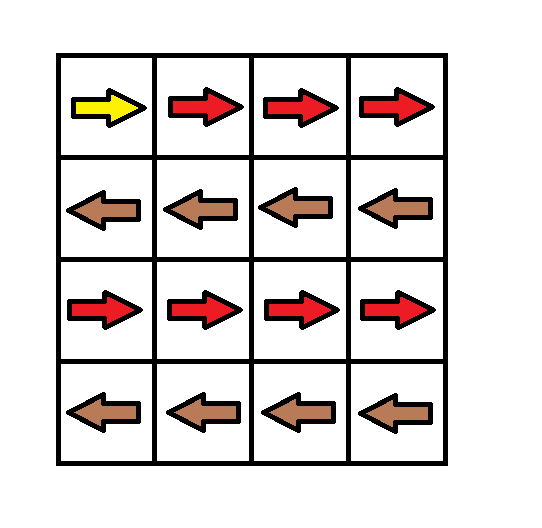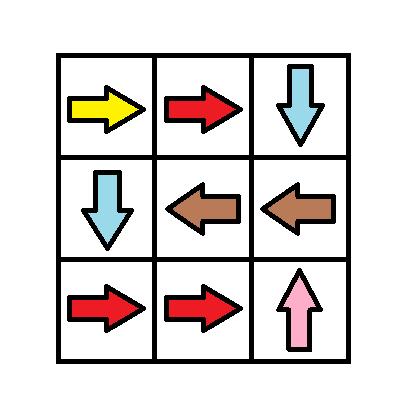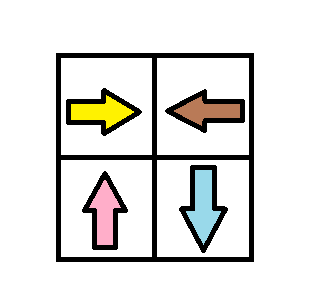问题:
给定n*m二维数组grid,要求从左上角(0,0)->右下角(n-1,m-1)
移动规则:grid[i][j]
1:right -> grid[i][j + 1]
2:left -> grid[i][j - 1]
3:down -> grid[i + 1][j]
4:up -> grid[i - 1][j]
若按照grid[i][j]所述的方式移动,无消耗。
否则可改变为余下的移动方向,则消耗为 1。
求要到达目标位置,最小消耗是多少。
Example 1: Input: grid = [[1,1,1,1],[2,2,2,2],[1,1,1,1],[2,2,2,2]] Output: 3 Explanation: You will start at point (0, 0). The path to (3, 3) is as follows. (0, 0) --> (0, 1) --> (0, 2) --> (0, 3) change the arrow to down with cost = 1 --> (1, 3) --> (1, 2) --> (1, 1) --> (1, 0) change the arrow to down with cost = 1 --> (2, 0) --> (2, 1) --> (2, 2) --> (2, 3) change the arrow to down with cost = 1 --> (3, 3) The total cost = 3. Example 2: Input: grid = [[1,1,3],[3,2,2],[1,1,4]] Output: 0 Explanation: You can follow the path from (0, 0) to (2, 2). Example 3: Input: grid = [[1,2],[4,3]] Output: 1 Example 4: Input: grid = [[2,2,2],[2,2,2]] Output: 3 Example 5: Input: grid = [[4]] Output: 0 Constraints: m == grid.length n == grid[i].length 1 <= m, n <= 100
example 1:

example 2:

example 3:

解法:BFS,Dijkstra,priority queue
使用优先队列,权值为:cost
优先处理cost较小的状态。
- 状态:cell坐标
- visited也保存cell坐标,
- ⚠️ 注意:但是由于可能会重复到达同一个坐标,cost不同,那么选择cost更小的路径,这里即用到了(从(0,0)到当前cell的)最短路径。
- 因此visited保存:到对应cell的cost:unordered_map<int, int> //i*100+j, cost
- queue里保存:权值cost,cell坐标 (i, j)
- visited也保存cell坐标,
- 对当前状态的处理:
- 如果cell坐标==target,那么返回当前权值cost
- 否则,进行下一步选择:
- dir四个方向:若!=gird[当前cell坐标],cost++
- 若next cell的visited中保存的cost更小,那么选择当前的路径到达next cell。更新visited[next cell]
- 同时将next cell的状态push到优先队列中。
代码参考:
1 class Solution { 2 public: 3 vector<vector<int>> dir = {{0,0},{0,1},{0,-1},{1,0},{-1,0}}; 4 int m,n; 5 int minCost(vector<vector<int>>& grid) { 6 n = grid.size(); 7 m = grid[0].size(); 8 priority_queue<pair<int, pair<int,int>>, vector<pair<int,pair<int,int>>>, greater<pair<int,pair<int,int>>>>q; 9 //cost, {i,j} 10 unordered_map<int,int> visited;//i*100+j, cost 11 q.push({0,{0,0}}); 12 visited[0]=0; 13 while(!q.empty()) { 14 auto [cur_cost, cur] = q.top(); 15 q.pop(); 16 //cout<<"pop: cost:"<<cur_cost<<"{x,y}: "<<cur.first<<","<<cur.second<<endl; 17 if(cur.first == n-1 && cur.second == m-1) return cur_cost; 18 for(int i=1; i<5; i++) { 19 int x = cur.first+dir[i][0]; 20 int y = cur.second+dir[i][1]; 21 int cost = cur_cost; 22 if(x<0 || y<0 || x>=n || y>=m) continue; 23 if(grid[cur.first][cur.second]!=i) cost++; 24 if(visited.count(x*100+y) == 0 || visited[x*100+y]>cost) { 25 visited[x*100+y] = cost; 26 q.push({cost, {x,y}}); 27 //cout<<"push: cost:"<<cost<<"{x,y}: "<<x<<","<<y<<endl; 28 } 29 } 30 } 31 return m+n-2; 32 } 33 };